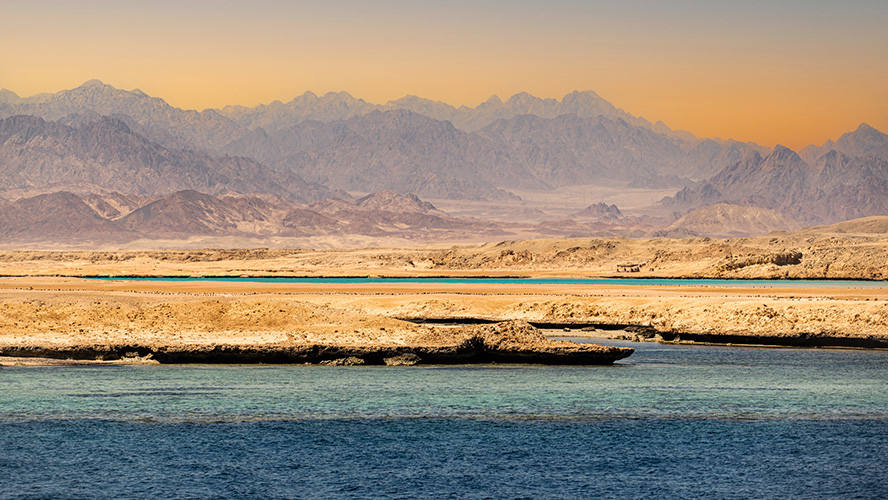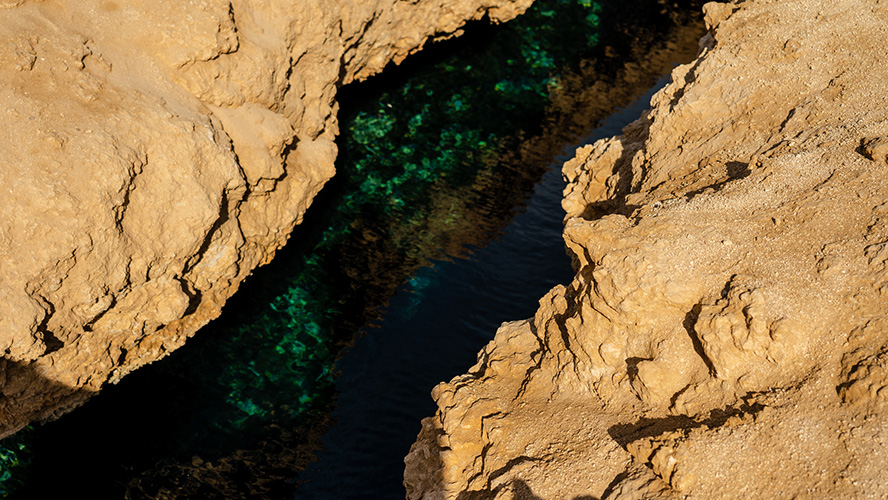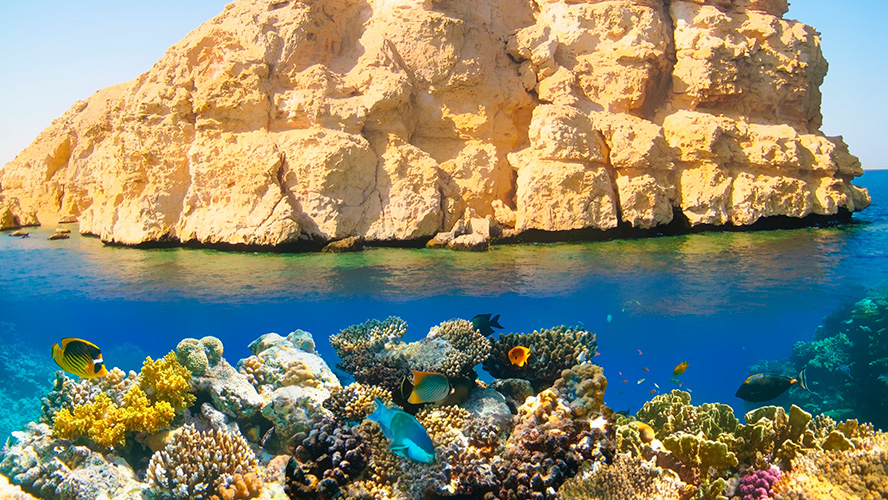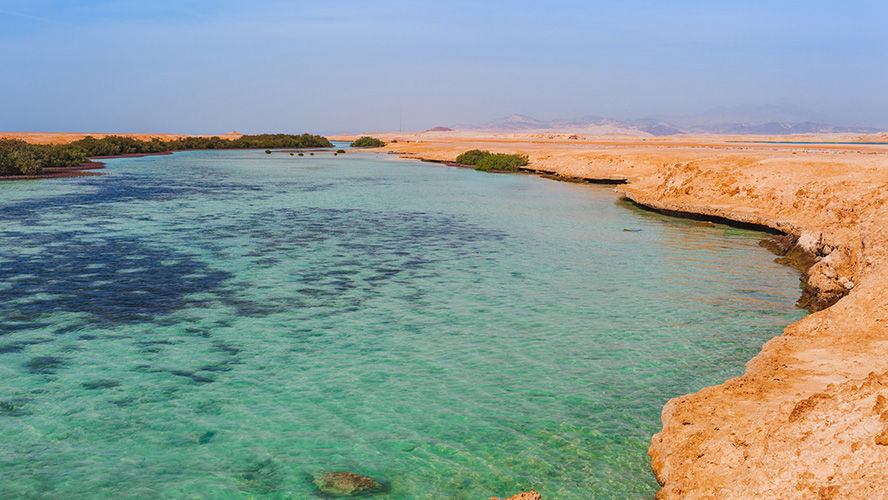Ras Mohamed Nature Reserve, located at the southernmost tip of the Sinai Peninsula, around 12 kilometres from Sharm el-Sheikh, is an astonishing natural underwater and land haven. Known as one of the jewels of the Red Sea and one of Egypt’s main nature reserves since 1983, it not only offers exceptional scuba diving among reefs that are home to 220 species of coral, but is also a key destination for biodiversity enthusiasts. Surrounded by an arid, mountainous environment of rocky cliffs, lagoons and mangrove swamps that stretch like an oasis among the sands, the desolate landscape contrasts dramatically with the lush marine fauna. Ras Mohamed is a true ecological sanctuary where desert and ocean meet to create a unique ecosystem.
History and natural setting: Ras Mohamed, where geology and ecology converge
Ras Mohamed was declared a nature reserve in 1983 to protect its valuable natural resources. The unique combination of geographical features, such as the steep cliffs that surround the area and the coral reefs that jut out into the sea, makes this an extraordinary site. The peninsula on which it is located has been shaped over millions of years by tectonic activity, resulting in geological formations that blend desert plains, mountains and spectacular coastlines.
The nature reserve is home to a large variety of land and marine species. The warm currents of the Red Sea and the geographical location of the Sinai Peninsula have enabled Ras Mohamed to be home to hundreds of marine species, many of them endemic. Also, on the mainland, it is common to find desert foxes, gazelles and, if you are lucky, even migratory birds that use the region as a stopover on their route between Africa and Europe. In short, Ras Mohamed is a melting pot of biodiversity, protected not only for its ecological importance, but also for its natural beauty.
Ras Mohamed Nature Reserve was established in 1983, the first of its kind in Egypt. Its creation was no accident: it came about in response to the urgent need to protect the region’s unique ecosystem from the impact of increasing tourism and human activity. Before being declared a nature reserve, Ras Mohamed was already known for its extraordinary coral reefs, which attracted scuba divers and scientists from all over the world. Nevertheless, conservation efforts enabled the area to remain a sanctuary for a vast array of marine species, many of which are endangered.

The reserve covers more than 480 km² of land and sea, including 133 km² of desert and mountainous land and 345 km² of an underwater world teeming with coral reefs. This vast protected territory is home to more than 200 species of coral and 1,000 species of fish, many of them endemic to the Red Sea. Also, on the mainland, it is common to find desert foxes, gazelles and, if you are lucky, even migratory birds that use the region as a stopover on their route between Africa and Europe. Over the years, Ras Mohamed has been a hotspot for scientific studies of marine life, and has established itself as one of the world’s main sites for marine biodiversity conservation. The currents of the Gulf of Aqaba and the Gulf of Suez converge there, providing a rich blend of nutrients that lead to an abundance of marine life.
In addition to its ecological value, Ras Mohamed has been a strategic crossing point for thousands of years. Historically, the region served as a connecting point between Africa and Asia, and its waters have been criss-crossed by trade routes connecting East and West. Although the reserve is mainly renowned for its marine biodiversity, its land environment provides an austere and fascinating beauty. The rocky cliffs and plateaus, which tower above the coast, tell stories of a geological formation that dates back millions of years of tectonic activity, when the Red Sea began to open up and form the Sinai Peninsula.
In short, Ras Mohamed is a perfect example of how natural history and human conservation intervention can coexist, enabling travellers to explore an untouched paradise, both on land and under water.
Must-see sites: seismic faults and lagoons saltier than the Red Sea
Beyond the deep sea, Ras Mohamed Nature Reserve offers spectacular landscapes that should not be missed. One of the most impressive is formed by a geological crack that runs through the nature reserve’s floor, resulting from the seismic activity in the region. They are faults up to 40 metres long and 1.5 metres wide, filled with water with a depth of more than 14 metres. This phenomenon is a tangible sign of how the tectonic forces that separated Africa from the Arabian Peninsula continue to shape the land.
Another must is the Salt Lake, a natural lagoon whose salinity is even greater than that of the Red Sea. With an almost magical blue colour, this lake located about 200 metres from the mangrove channel, is known not only for its beauty, but also for its healing properties, which makes it an ideal spot for relaxing while floating in its calm waters.
Visitors must not miss the land fauna that inhabits the nature reserve, although this often goes unnoticed due to the reputation of the marine biodiversity. Among the desert inhabitants you may spot are desert foxes, Sinai hares and several species of migratory birds that use Ras Muhamed as a crucial resting point on their journey between Africa and Eurasia. These small moments of life in the midst of a barren landscape underline the amazing diversity that the reserve has in every nook and cranny.

Beaches at Ras Mohamed: white sands, turquoise waters and coral reefs full of life
Ras Mohamed Nature Reserve is home to some of the most beautiful beaches on the Red Sea. Main Beach is famous for its white sand and crystal clear waters, making it the perfect place for relaxing after a day of exploring or scuba diving. Its waters are calm and shallow and, with the vertical coral walls, it is one of the best beaches for snorkelling and exploring the nearshore reefs.
Another outstanding place is Yolanda Beach, known for the remains of a cargo ship that sank in the area in the 1980s, the SS Yolanda. Although most of the ship lies on the seabed, some wreckage is still visible, and the site has become an artificial reef that attracts scuba divers from all over the world. Also of interest is Aqaba Beach, where you can scuba dive in an Eel Garden, i.e. a colony of garden eels.
The beaches at Ras Mohamed are not only places where you can relax but they are gateways to an underwater universe teeming with life.
Dive sites: Shark Reef and Yolanda Reef are among the best in the world.
Ras Mohamed’s main attraction is clearly its spectacular dive sites which are acknowledged to be among the best in the world. Shark Reef and Yolanda Reef are two of the most famous, with an impressive variety of corals running down vertical walls, tropical fish and, as the name suggests, the opportunity to observe reef sharks in their natural habitat. The reefs are located at the confluence of several ocean currents, favouring the concentration of marine life in the area.
Experienced scuba divers can descend into the Submarine Canyon, a deep crevice in the seabed that provides a unique swimming experience among the vertical canyon walls, covered in coral and surrounded by schools of colourful fish.

Mangroves: a surprising ecosystem in the desert
One of the most striking aspects at Ras Mohamed is the presence of mangroves, an ecosystem not commonly associated with arid areas such as the Sinai, but in more tropical areas in the south. In fact, this is one of the northernmost mangrove forests in the world.
Located in the southern part of the reserve, they are a green oasis in the middle of the desert, act as a natural barrier against erosion and provide a habitat for numerous marine and bird species. Mangroves are an excellent site for bird watching since many migratory species use them as temporary shelter. This contrast between the dryness of the desert and the lushness of the mangroves is one of the great attractions at Ras Mohamed.

How to get there and recommendations for visitors: practical tips
Ras Mohamed Nature Reserve is relatively easy to reach from Sharm el-Sheikh, which is around 12 kilometres to the north. There are various transport options, including taxis and organised trips including guided tours and activities such as snorkelling and scuba diving.
The recommendation is to visit the nature reserve during the cooler months, between October and April, when temperatures are more pleasant and outdoor activities can be better enjoyed. In the summer, the heat can be extreme, although scuba diving remains popular due to the constant water temperature.
Remember to bring everything you need for the day since the infrastructure at the nature reserve is limited. Water, sunscreen, a hat and comfortable clothing are essential to explore the nature reserve safely and make the most of your experience.










































































